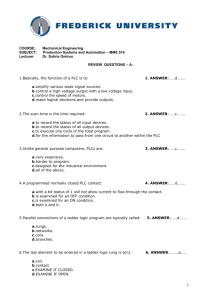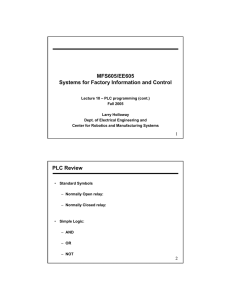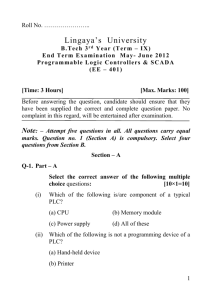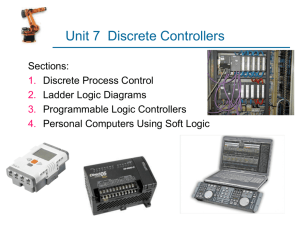MFS605/EE605 Systems for Factory Information and Control
advertisement
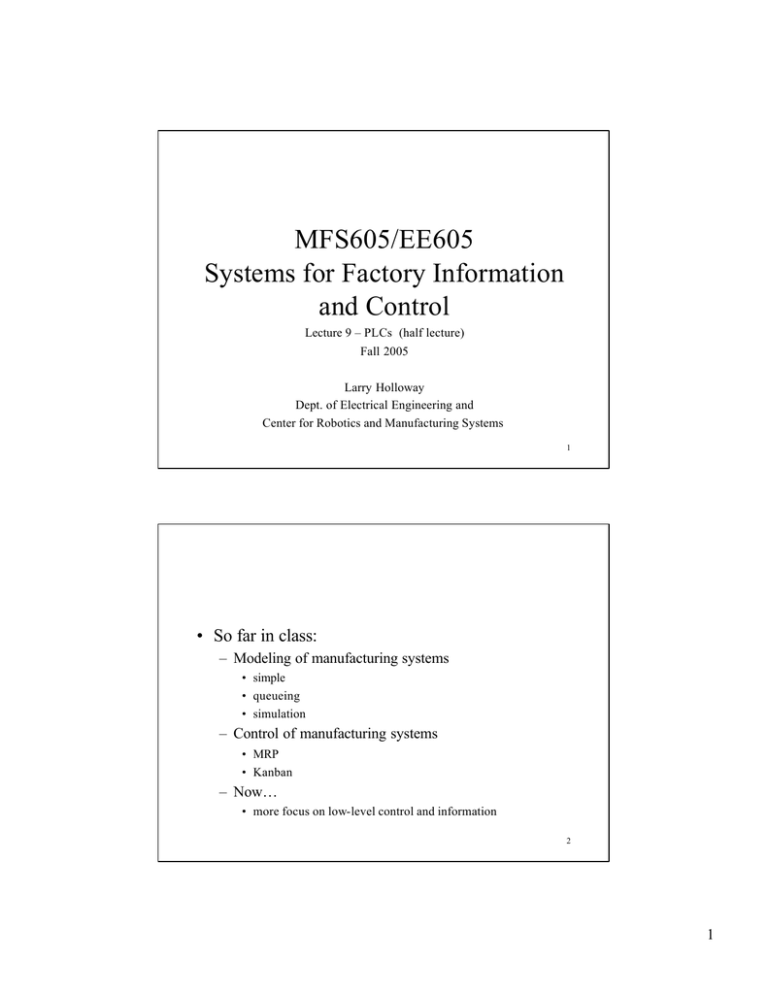
MFS605/EE605 Systems for Factory Information and Control Lecture 9 – PLCs (half lecture) Fall 2005 Larry Holloway Dept. of Electrical Engineering and Center for Robotics and Manufacturing Systems 1 • So far in class: – Modeling of manufacturing systems • simple • queueing • simulation – Control of manufacturing systems • MRP • Kanban – Now… • more focus on low-level control and information 2 1 • PLC: Programmable Logic Controller – Microcomputer-like instrument for controlling industrial equipment – “Programmable”: control can be modified – “Logic” operate primarily with on-off voltages as inputs and outputs • fans, motors, pumps, valves, warning horns/lights, etc. 3 • Example system: • Discrete actuation and sensing 4 2 Another Example: Fluid Control 5 Discrete Sensors • Limit Switches • Proximity Sensors: – Inductive – Capacitive – Magnetic/Hall effect • Photoelectric Sensors 6 3 Photoelectric Sensors Through beam Reflection from target RetroReflection Infrared vs. visible, pulsed vs. constant, use of fiber 7 Other sensing applications (Variations on basic sensors described) • Liquid level • Temperature • Pressure 8 4 Actuation • Discrete Actuation: – Motors off and on – Lamps – Buzzers – Heating Coils – Etc. 9 Logic implementation • • • • • Electronic logic gates Programmable logic devices (PALs, FPGA’s) Relays Hydraulic/Pneumatic logic Computer based 10 5 Interfacing logic • Relays – Basic terminology: NC, NO, Coil, SPST, DPST 11 12 6 Interfacing logic • Optoisolators 13 • PLC: Programmable Logic Controller – Microcomputer-like instrument for controlling industrial equipment – “Programmable”: control can be modified – “Logic” operate primarily with on-off voltages as inputs and outputs • fans, motors, pumps, valves, warning horns/lights, etc. 14 7 Why PLCs? • rugged for reliable operation in industrial environments • operating systems won’t crash or hang-up • designed for extensive I/O -- easily interfaced – – – – examples: 220VAC input and output current I/O thermocouple I/O etc. • Designed for industrial programming: 15 – Ladder logic, Sequential Function Charts, Basic, … Disadvantages of PLCs: • Often limited arithmetic/computational capability • Typically missing the ability for extensive datalogging, user-interface, and other “PC” computer tasks. • Ladder logic programming languages primitive -hard to debug or maintain large programs 16 8 PLC Background • Sequential control used to be accomplished by hardwired banks of relays: – Simple logic of relays: • AND • OR • NOTs 17 • Hardwired relays still used in some applications, but several problems: – Hard-wiring is time consuming, doesn’t allow rapid change of logic. – Hardware is failure prone, noisy. • In the 1960’s, push (by GM and others) to replace Relays with a software equivalent • More recently: communications, networking, more advanced functions, faster processors, better software languages 18 9 Structure of PLC • Modular System: pieces easily interchanged Power Processor Comm. supply Example I/O Modules: • 5v DC • 24VDC • • • • 110VAC 220VAC 3-phase AC current I/O Modules • • • • PID controllers “Fuzzy” control modules Thermocouple interfaces etc. 19 • Where is the keyboard and monitor? – Unnecessary in normal use: only used when programming • either program on PC and download, or have auxiliary programming station • Where is the disk? – Disks often vulnerable in harsh environments, so not typically used – Programs typically small and stored in memory (RAM, EPROMS, or Flash) 20 10 Typical PLC Architecture Program RAM CPU System Data I/O ROM RAM Unit battery Latch Interface common Relays Buffer Filter Optoisolators (or relays) 21 PLC Programming -- Ladder Logic Ladder Logic is software version of original relay control circuitry. • Advantages: – direct extension of the control methods previously used – simple to do simple logic • Disadvantage: – seems primitive – difficult to do complex logic and sequencing – 22 11 Basic Ladder Logic Diagram (Program) output Logic Circuit (see next slides) power rail X134 ground rail 23 • Standard Symbols – Normally Open relay: – Normally Closed relay: X134 X134 • Other Symbols (less common): – Positive transition sensing – Negative transition sensing 24 12 Coils • Output coils vs. internal coils (memory coils) • Standard types: – Coil – Negated Coil – Set Coil – Reset Coil – Retentive Memory Coil – Positive Transition Sensing Coil – Negative Transition Sensing Coil 25 • Simple Logic: – AND X134 X134 X126 O001 O002 – OR X126 – NOT X134 O003 26 13 • Assume power high rung and power low rung. • Outputs of system (and intermediate logic variables) are on when “current” flows to them through logic. • A ladder program is then a sequence of these ladder rungs • EXAMPLE: (safety system): Machine is on if pushbutton 1 is on and safety sensor is low, or if pushbutton 2 is on, but never when the emergency stop is pushed. 27 •EXAMPLE: (safety system): Machine is on if pushbutton 1 is on and safety sensor is low, or if pushbutton 2 is on, but never when the emergency stop is pushed. 28 14 • Typical operation: – – – – – scan inputs (to image register) execute program output status (from image register) housekeeping, diagnostics, communications Repeat • The time to repeat this is called the “scan time” – Depends on • # of program rungs • Speed of processor • (# of inputs, # of outputs) – 1-25msec is common • Scan time issues…(immediate I/O updates) 29 Scan issues • How many scans before Y2 is true? X1 Y1 Y1 Y2 30 15 Memory Logic: Feedback within rungs EXAMPLE: X7 is start switch X8 is stop switch X9 is over-temperature switch Have motor Y3 on if start switch pressed in the past, as long as stop switch and overtemperature switch have not been true. 31 Have motor Y3 on if start switch pressed in the past, as long as stop switch and over-temperature switch have not been true 32 16 PLC’s lecture 3 33 • Modern PLCs have special function blocks including timers, counters, etc. • EXAMPLE (continued):Start switch X7 must be held down for at least 2 seconds before Y3 is started. 34 17 Timer Example 35 • PLC Programming (Lecture 18) 36 18 PLC Review • Standard Symbols – Normally Open relay: – Normally Closed relay: • Simple Logic: – AND – OR – NOT 37 PLC Programming • Simple Combinatorial Logic • State logic -- latching • Sequential logic 38 19 Simple Combinatorial Logic • Key steps: – Identify inputs and outputs – For each output, determine expression for what makes it true – Construct ladder logic to reflect expression 39 Combinatorial Example If “Oven On” switch is activated (S=1) and oven door closed (DLS=1) and Temperature below threshold (TLS = 0) then heat is on (H=1) If oven is on (H=1) or ( temp > thresh (TLS = 1) and door is closed (DLS=1) ) then fan is on (F=1) If oven is on (H=1) or light switch is on (LS=1) then light is on (L=1) 40 20 State Logic -- Latching • Key steps: – Identify inputs and outputs. Consider outputs to be state variables – For each state variable X, • determine expression ResetX of what makes state go false • determine expression SetX of what makes state go true – Construct ladder logic to reflect the following expression: ______ (ResetX ) (SetX + X) → X _____ (If you have difficulty converting ResetX into ResetX , then you may use a different rung to calculate ResetX, , then invert it in 41 the rung for X Example Tank System: • S1 is turned on whenever level is below LLS switch (LLS=0) • S1 is turned off when level above ULS switch (ULS =1) 42 21 Example • Motor Control – Turn on motor when On-switch is pressed – Turn off motor when Off-switch is pressed, or when temperature sensor is high. 43 Sequential Logic -- Cascade method • Sequential Logic has steps. – The functions that drive the outputs differ depending upon which step is being done • Use extra state variables to represent which step is active – Draw state diagram representing steps, indicating what causes changes in the states – Establish “Flip-Flop” rung for each step – Define Output rungs that depend on the steps – Initialization rung may be required 44 22 Sequential Logic -- Example • An industrial oven has four states, Off, Preheat, Superheat, and CoolDown. The oven starts in the Off state. If start is pushed, • then it enters the Preheat state and turns the heater on. It remains in the preheat state until the temperature sensor T1 becomes true, at which time it then enters the Superheat state. In this state, it continues to heat, but locks the oven door. Once temperature sensor T2 becomes true, then it moves to state CoolDown, where the heater turns off. The door remains locked, until the sensor T1 becomes false, at which point the OFF state is entered and the door is unlocked. • There is a stop switch also, but it only works during the preheat state, and returns the system to off. 45 Industrial Oven -- state diagram 46 23 Industrial Oven -- Ladder Program 47 • Auto-ID 48 24
